The Geographer
c. 1668–1669Oil on canvas
53 x 46.6 cm. (20 7/8 x 18 1/4 in.)
Städelsches Kunstinstitut, Frankfurt am Main, Germany
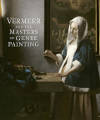
Blaise Ducos
"Reaching for the Stars" - Vermeer and the Masters of Genre Painting: Inspiration and Rivalry2017, pp. 208-213
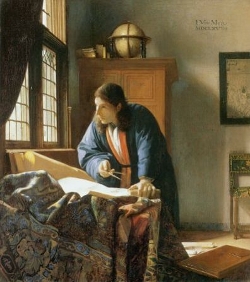
Johannes Vermeer
c. 1668–1669
Oil on canvas, 53 x 46.6 cm.
Städelsches Kunstinstitut, Frankfurt

Johannes Vermeer
1668
Oil on canvas, 50 x 45 cm.
Musée du Louvre, Paris
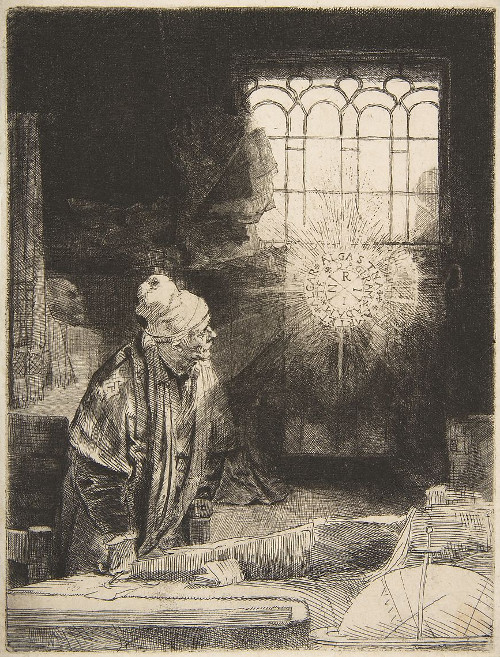
Rembrandt van Rijn
c. 1652
Etching, drypoint, and burin; fifth of seven states, 21.7 x 16.7 cm.
Metropolitan Museum of Art, New York
Scholars have long attempted to trace relationships between Vermeer’s Astronomer (fig. 1) and Geographer (fig. 2) and contemporary paintings, drawings, and prints. It is not easy, however, to decide which works served as direct inspiration to the Delft artist. If Rembrandt’s etching Faust (fig. 3) is excluded on the grounds that its similarities are limited to shared subject-matter, we should turn our attention to other models that Vermeer was likely to have known. Examination of the objects in Vermeer’s paintings can provide some guidance in the search for visual sources. For example, it has been noticed that the stool in The Geographer has its origins in Gerard ter Borch’s work. However, it is the composition of each painting that points towards their real source of inspiration. It appears to be the Leiden artist Gerrit Dou who is the main precursor of Vermeer. His Astronomer by Candlelight (fig. 4) from about 1660 contains most of the essential props to be found in Vermeer’s two later paintings: the large, open folio (visibly worn), the hand on the globe, and the protagonist’s distant gaze. The flask and hourglass connect Dou’s figure to the domain of misguided, sometimes absurd research carried out by alchemists pursuing eccentric theories, as painted by several Haarlem artists, including Thomas Wijck (fig. 5) and Cornelis Bega (fig. 6). In Dou’s painting, the scholar is a mature, bearded man whose features are represented in painstaking detail: one senses that he has already wasted years searching long into the night. In this context, the night is a metaphor for the darkness in which the human mind gropes for knowledge.

Gerrit Dou
c. 1665
Oil on panel (arched top), 32 x 21.2 cm.
The J. Paul Getty Museum, Los Angeles
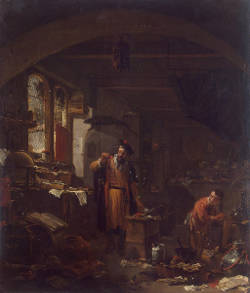
Thomas Wijck
Second half of 17th century
Oil on panel, 41 x 35.5 cm.
Hermitage Museum, Saint Petersburg
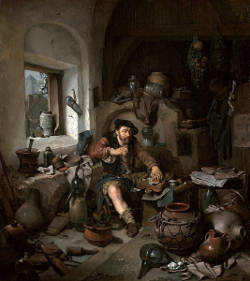
Cornelis Bega
1663
Oilon canvas, 35.5 × 32 cm.
Getty Center, Lost Angeles
A few years later, in about 1665, Dou painted another Astronomer by Candlelight. He changed the protagonist into a young man who still holds a candle in a room steeped in darkness, but this time he uses it to read his book. The compass in the man’s left hand is depicted as clearly as the half-full flask and the hourglass with the sand running through it. The astronomer’s elegance is indicated by the detail of the lop-sided purple cap: Vermeer was to remember this fashionable touch. In Dou’s second painting, the night scene also stands as a metaphor for ignorance that must be dispelled.
The composition of Dou’s paintings makes them exceptional, as does their format: their small scale does not preclude monumentality in the composition. In both works, the lofty architectural space just visible behind the astronomers allows the painter to suggest unfathomable depths. The figures emerge from this enigmatic shadow, in which the eye founders, and, by a masterly sleight of hand, the painting is enriched with a third dimension which a first glance at its frieze-like composition might seem to declare impossible. Vermeer reacted to this subtlety in The Geographer and The Astronomer, but although the two paintings are indebted to Dou, they also break free from his influence. They abandon the preciosity of the Leiden artist’s ‘fine’ painting. This rejection, at a distance of only a few years, reveals much about Vermeer’s artistic independence. The stylistic metamorphosis is so persuasive that Dou’s legacy is almost imperceptible.
The scarcity of single male figures in the work of Vermeer means that The Geographer and The Astronomer occupy an exceptional position in the artist’s oeuvre. The paintings, undoubtedly designed as a pair and painted over a relatively short period (one year apart), are a hymn to the scientific revolution of the seventeenth century—praise for global navigation as much as for international relations, both then dominated by the Dutch. This is suggested by the presence of Adriaan Metius’s book, which lies open on the astronomer’s table, the Jacob’s staff (an instrument used at sea to measure the height of the stars), the celestial and terrestrial globes, and the maps, all of which have received much attention in the literature. Moreover, Vermeer’s male figures are dressed in non-European clothing—a type of indoor robe derived from a kimono called a "banyan." The extra-large planispheric astrolabe (the stand obscured by the rug on the table) in The Astronomer is certainly based on contemporary versions carefully observed by Vermeer. It is remarkable that the Delft artist had access to such objects and here it serves as an illustration of the significance of the Dutch Republic as a seafaring nation. In general, Vermeer took particular care when painting these instruments: the cosmopolitan, contemporary dimension conferred by their presence is an essential feature of the two paintings. In this respect, Vermeer’s painting outstrips the more picturesque character of Dou’s two Astronomers.
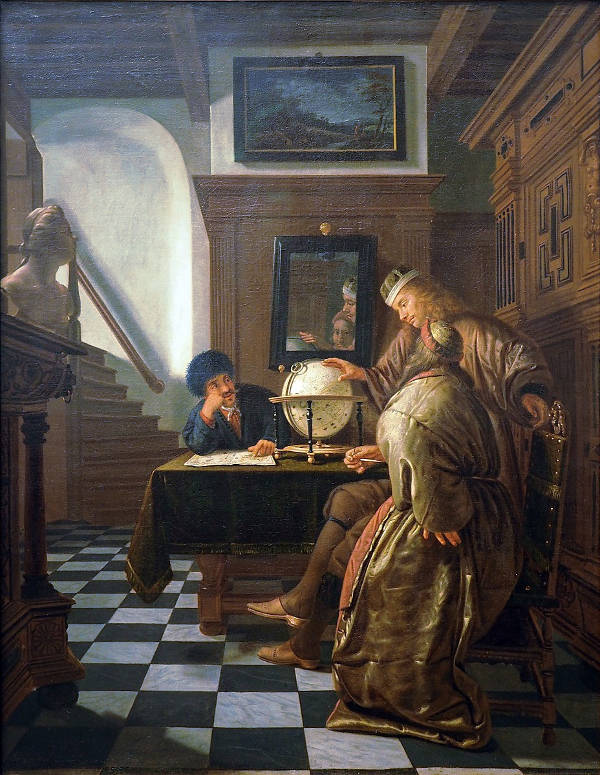
Cornelis de Man
-
Oil on canvas
Hamburger Kunsthalle, Hamburg
Successors in line to Vermeer’s companion pieces are rare. Noteworthy among them are Cornelis de Man’s Astronomers at Work (fig. 7), in which the scholar bends over a globe, or his Interior with a Scholar, both dating to the early 1670s. These compositions pay unreserved homage to Vermeer. The extent to which De Man borrows Vermeer’s accessories is startling, but the gravitas of the earlier works passes him by.
The later of Vermeer's two dated pictures was painted twelve years after The Procuress and seven years before his death. Half a dozen other pictures seem to show some affinity of style with this work, The Astronomer and its pendant; together they form the group which provides the last entries in the present list. Such evidence as we have of the order in which they were painted is far from conclusive. Some of them have a broad and somber richness not quite characteristic of any earlier period; The Astronomer and The Geographer share the quality with the picture in which appears the boldest of all the painter's uses of his optical substitute for modeling, the Red Hat. In all three the light and shade on massive draperies make a sumptuous pattern liberated from form. The incomparable simplicity of the Beit Letter approaches a similar effect. Further light on this phase may be gathered from the emergence of a decorative elaboration, the quality which, appears in the bright enameling of The Love Letter. It is most marked in the Allegory and the pictures at Trafalgar Square.
These last stand rather apart from the rest of the group. In tonality and subject they represent one of those reversions which occur at intervals in the painter's development to provide a warning to the student. The Allegory and the The Guitar Player evidently belong to the same phase and the styles, as well as the costumes, of the letter pictures at Amsterdam and in the Beit collection can date from little earlier. These six are the only pictures which there is reason to place after The Astronomer and The Geographer in the last seven years of Vermeer's lire. Yet we have no sense that his activity was cut short: his style reached its natural conclusion. Vermeer's widow is recorded to have stated that he earned little in his final years. In the context the fact would be easy to understand.
In The Astronomer and The Geographer Vermeer dealt, according to his habit, with subjects which were the common property of his school. In particular, he can hardly have been unaware of the numerous pictures of scholars in their studies by Rembrandt and his circle. Among these it is interesting to notice that the nearest precedent for the arrangement of Vermeer's versions is again to be found in drawings by Nicolaes Maes (fig. 8). It does not appear that even these figures can be credited to Vermeer's invention. The Geographer takes up precisely the position of Faust in Rembrandt's famous etching (fig. 9) and in the resemblance we can for once trace Vermeer's radiant and contemplative moment to its source. Vermeer, whose cast of thought was as unlike Rembrandt's as that of any painter, yet must have owed some of the very foundation of it, some of the intensity with which the problems of figure painting presented themselves to rum, to the example with which the master confronted his generation. But it is perhaps significant that only here, as the tension of his own pressing problem and the limitations it imposed at last relax, do we discover a direct link to confirm the relationship which his whole development suggests.

Nicolaes Maes
1640s–50s
Drawing withg brown ink and brown wash on antique laid paper
Fogg Art Museum, Harvard University
We have a curious evidence of the currency of Vermeer's motif in The Astronomer. Another Astronomer, now in an American collection, which has sometimes been ascribed to him, shows the scholar in a very similar pose. Of the signature on which the attribution rests only the first letters are said to be visible the name of Metsu would be among those which the general appearance of the work would call to mind but elsewhere the picture bears the trace of an inscription of greater interest, a date of 1665. Whether or not it can be credited this version of unknown authorship is evidently the older of the two. Possibly both derive from a common source; material to complete the history of the motif has disappeared.

Rembrandt van Rijn
Between 1650 and 1654
Etching, drypoint and burin on eastern paper, 20.8 x 16 cm.
Rijksmuseum, Amsterdam
The Nautical Map on the Background Wall

Kees Zandvliet
"Vermeer and the Significance of Cartography in His Time."in The Scholarly World of Vermeer, Zwolle,
1996, pp. 65–66
Who taught Vermeer cartography?
We do not know whether Vermeer received his mathematical training from a Delft surveyor. Perhaps his teacher was the man portrayed as the scientist in The

Antonie van Leeuwenhoek. Letter of June 12, 171
Geographer and The Astronomer. Given that the instruments depicted—such as Jacob's staff and compasses—were indeed practical instruments, it would seem that Vermeer did not intend to paint an arm-chair scientist. In fact, it has been suggested that the scientist portrayed here is none other than Antonie van Leeuwenhoek (fig. 10).
This well-known Delft contemporary of Johannes Vermeer fits the picture of the learned man who derives his knowledge from literature as well as from factual observations. Moreover, Van Leeuwenhoek was a licensed surveyor. Although we know of no maps from his hand, his knowledge of mathematics would certainly come in very handy in his capacity as wijnroeier (municipal comptroller of wine sales) and in his research and instrument making.
As Van Leeuwenhoek's name is also recorded in documents in connection with Vermeer, it is quite possible that he helped Vermeer in the practical application of perspective. Another candidate is the surveyor Johannes de Weert. He qualifies because he trained would-be surveyors and is mentioned as a teacher in a more general sense: he was a schoolmaster and lay reader in the Nieuwe Kerk. More light might be thrown on Vermeer's mathematical training by research in the Delft archives on surveyors. But such research would probably not explain the depiction of imposing wall maps (fig. 11) and globes (fig. 12) in Vermeer's painting, for these were made not by professional surveyors but by cartographers.

Willem Janszoon Blaeu
1635 (Amsterdam)
Hand colored 21.5 x 16.5 in.

Johannes Vermeer
c. 1668–1669
Oil on canvas, 53 x 46.6 cm.
Städelsches Kunstinstitut, Frankfurt am Main, Germany
Dressed in a Japanese-style robe popular among scholars at that time, the geographer is someone excited by intellectual inquiry. Surrounded by maps, charts, books, and a globe, he rests one hand on a book and holds dividers with the other. As opposed to the women in Vermeer's paintings, who are quiet and self-contained, the geographer's active stance indicates an alert, penetrating mind. Vermeer not only captured the scholar's energy, he surrounded him with accurately rendered cartographic objects appropriate for a geographer's study.

Johannes Vermeer
c. 1668–1669
Oil on canvas, 53 x 46.6 cm.
Städelsches Kunstinstitut, Frankfurt am Main, Germany
The decorative sea chart on the rear wall (fig. 13), showing "all the Sea coasts of Europe," is by Willem Janz. Blaeu (fig. 14). Hendrick Hondius' terrestrial globe, which rests on the cabinet in its four-legged stand, is turned to reveal the Indian Ocean, the route taken by the Dutch to reach China and Japan. Other instruments include the dividers, used to mark distances a square lying on the stool in the foreground and a cross-staff, used to measure the angle of the elevation of the sun and stars, hanging from the center post of the window. Among the various rolled charts in the room, the large one on the table is probably a nautical chart made of vellum.
The seventeenth century was a time of discovery, when the charting of new and unexplored worlds was a dream realized not only by adventurers and traders but also by geographers and astronomers. From the rime of the first successful trading venture to the South Pacific in 1599 and the arrival of the good ship Liefde on the northeast coast of Kioesioe in April l600, the fruits of the ever-expanding mercantile empire brought Dutch citizens both wealth and marvelous rarities from distant lands.

Willem Janszoon Blaeu
Amsterdam
1621

